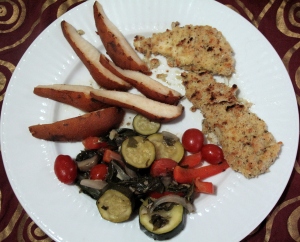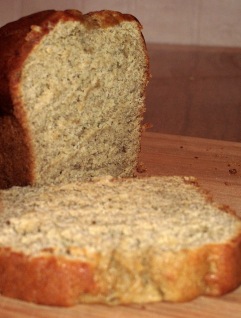I apologize for how much time has passed since my last post: I was down for almost 2 weeks with a bad case of bronchitis. I am now pretty much caught up to the speed of life now, but it took a while for me to be able to have the time to sit down and type up a post.
And actually, a couple of things happened as a result of the bronchitis that are pertinent here.
Firstly, I quit smoking. I finally just got fed up with all of the expense and the health consequences of smoking, and it has now been almost three weeks since my last cigarette. Go, me! Since then, I have really noticed the improvement of my senses of taste and smell. I can hardly believe it: cooking and eating are even more enjoyable to me than they were before.
Secondly, I had a lot of time to think as I was laying down, barely able to function, weary and sick with a head full of medicine: a long enough time, in fact, that I eventually got around to thinking about my priorities in life, whether I’m living up to my potential, and what I could stand to work on in order to be living the most authentic, healthy life possible. Blah, blah, blah.
Of all the things that occurred to me as I (literally feverishly) considered my life-in-general, one was the importance of being more financially responsible. I have committed to depositing a percentage of each and every paycheck into an IRA (the account type, not the army type), just the way real grown-ups do. No excuses, no justifications.
And, in addition to not smoking, one of the ways that I am going to free up the funds to do so is to work to keep my food expenditures down: I spend a perhaps disturbingly high percentage of my income on yummy foodstuffs. I love yummy foodstuffs. However, I am going to be dedicating more mindfulness to feeding myself on healthy, yummy foods that are also economical.
This recipe is going to be the first in a series of recipes that I will make that require less than $20 in purchases from Wegmans. Every recipe that I am able to make for less than $20 will be tagged with “LessThan20.”
Keep in mind that I have a fairly well-stocked kitchen, so I rarely have to purchase all of the ingredients in any given recipe. Also, these prices reflect their cost at the Wegmans stores in Rochester, NY. You may have to spend more than $20 on these recipes, depending on what you already have on-hand and the prices of items in the area where you live.
So, yeah, that’s that. Now on to the recipe that is the real focus of this post…
This recipe is one that my Mom used to make sometimes, and it was always one of my favorites.It stands out in my mind as one of my favorite comfort foods. The buttery, flaky crunch of the crust; the heavenly fragrance and melty, delectable flavor of the filling; the cool smooth finish of the cucumber sauce that stands in perfect complement to the turnover… it’s a pure delight to eat.
Sadly, many years have passed since the last time I was lucky enough to have this dish. I just never remembered to ask Mom for the recipe, and so memories of this dish have taunted me and left me in a perpetual unsatisfied void of craving. -heavy sigh-
Until earlier this week. I finally remembered to ask Mom if she could please send me the recipe for this delightful, satisfying, creamy, buttery, veggie-ful, beautiful entree with a tender, flaky crust. And, joy of joys, she found it and sent it my way.
I decided I had waited long enough, and that I just had to make it right away. So, within 24 hours of getting the recipe, I was at Wegman’s grabbing all the ingredients that I needed to create the dish that had, for so long, been haunting me with its elusiveness. The only ingredients I had to purchase were the zucchini, parmesan, mushrooms, salmon and cucumber, for a total cost of $15.24. Huzzah!
Now, just a few helpful tips and tricks, and we can get right on to the recipe…
You can used canned salmon if you are short on time, but it’s so easy to grill salmon yourself that I recommend doing it. Just take the salmon steaks and score the skin by making several diagonal slashes approximately 1/4-inch thick. Coat the fish fairly liberally with olive oil, season lightly with salt and pepper, and place on a broiler pan with the skin side up. Broil 4-5 minutes per side, depending on the thickness of the fish.
(You could, of course, stop right there and serve the salmon next to whatever seasonal veggies you choose to and have a lovely meal. But, really, you should go ahead and make the turnover.)
Cut the zucchini into cubes about 1/2-3/4 inch per side. This is large enough that their color, flavor and texture stand out, but not so large that they cook unevenly and/or make the filling seem too lumpy.
Don’t fill the turnover beyond its capacity, or the crust will rip and the Senate in your home state will be taken over by Republicans (wait: did that already happen? Sigh.). Seriously, though, put in as much filling as you can, but make sure you will still be able to fold the crust over and seal it without overtaxing the fragile dough. If you have some of the filling left over, do not worry: you can saute it for a bit to cook the egg that’s in it and eat it on its own. In fact, have it with some of the cucumber sauce: this can be a helpful way to fine-tune the seasoning of the sauce as you aim towards the perfect balance of flavors.
I STRONGLY recommend using parchment paper for both the rolling out of the crust and for baking on. It is easier to roll our dough very thinly without it ripping or tearing when you use parchment paper, plus you can roll out the dough without adding additional flour (which can make the dough dry and tough. Blech.). It is beneficial for lining the baking pan, too, because you will easily be able to get the turnover from the pan to the serving plate or cutting board without damaging it. It is sad when, after working on a pastry-wrapped goody for a good chunk of time, the pastry surrounding the filling cracks into pieces. The result of such drama is usually a messy, funny-looking pile-o-gook which, while tasty, is harder to serve and sadder to look at.
Regarding cucumbers: they are more than 90% water by weight. Thassa lotta water. And, when using them in sauces or salads, it is enough water to cause some undesired consequences: sauces can get too thin, salads can get wilted and spoiled prematurely. As a result, when I use cucumbers in sauces or salads, I always de-seed them first. This is insanely easy: just cut the cucumber in half lengthwise and, using a teaspoon, simply scoop out the seeds. The center membrane and seeds contain the runniest of the cuke’s water weight, and so this one step can help keep your sauces the proper texture and your salads fresh and crisp for a longer time.
Don’t be shy with either the sesame seeds or the sauce. They take the turnover and transform it from yummy to positively delicious.
And that’s it! In case you haven’t caught on by now, I really like this recipe, and I hope you will, too! Enjoy.
Salmon Turnover with Cucumber Sauce
- 2-3 T butter or olive oil
- 1/2 c chopped onion
- 1 small yellow zucchini, in smallish bite-sized cubes
- 1 small green zucchini, in smallish bite-sized cubes
- 4 oz. mushrooms, sliced and coarsely chopped
- 1T flour
- 1/2 t dried marjoram
- 3 or 4 sprigs of thyme, leaves only
- 1/4 c milk or half and half
- 1 pound grilled salmon, cooled and flaked
- 1/4-1/2 c grated parmesan
- salt and freshly ground pepper
- 1 egg
- sesame seeds
- 1 recipe pie crust (below)
- 1 recipe cucumber sauce (recipe below)
- Saute the onion in the oil or butter until it is translucent. Add the zucchini and saute 2-3 more minutes before adding the mushrooms.
- Add the flour, mix well, and continue cooking for a few minutes. Add the herbs and stir gently for a few more minutes before slowly adding the milk or half-and-half. Cook until smooth, fragrant and bubbly.
- Stir in the salmon and the parmesan. Adjust salt and pepper to taste.
- Beat the egg. Add half to the filling and set the rest aside. Preheat oven to 350 degrees.
- Allow the filling to cool while you make the pie crust (recipe below). Form the dough into a ball and place between two sheets of parchment paper. Roll the dough into a circle with a diameter of at least 13 inches: it will be thin and fragile.Transfer the circle of dough onto a parchment paper-lined cookie sheet or pizza stone.
- Spoon the filling onto one half of the rolled dough, leaving a border approximately 1/2 inch deep around the edge. Be mindful to put in as much of the filling as will fit, but no more. Fold the other half of the dough over the filling and seal the edges.
- Cut a few slits into the top of the pastry, brush the dough with the remaining beaten egg, and sprinkle liberally with sesame seeds.
- Bake 25-35 minutes, until golden brown. Serve with cucumber sauce (recipe below).
Pie crust:
- 6 T cold butter, cut into small pieces
- 1 1/2 c flour
- 1/4 t salt
- 4-5 T cold water or milk (more or less)
- Using a pastry cutter or a food processor, cut together the butter pieces and the flour until they are the consistency of rough cornmeal. Add salt.
- Stirring with a fork (or leaving the food processor running on low), add the liquid 1 T at a time until the dough sticks to itself: stop adding liquid as soon as the dough holds together. The natural fluxuations in humidity will affect the amount of liquid that you will need to use.
- Wrap the dough well in plastic wrap and chill for about 45 minutes before rolling it out.
Cucumber Sauce:
- 1 cucumber, peeled, seeded and shredded
- 1/2 c sour cream
- 1/2 c mayonnaise
- 1 T rice vinegar
- salt and pepper to taste
- Drain the shredded cucumber for a few minutes to get rid of some of the extra water.
- Gently mix all the ingredients together. Fine-tune the vinegar, salt and pepper to your taste. That’s it!









